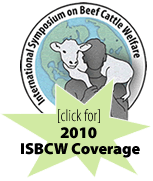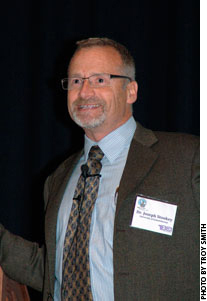 Weaning Management
Weaning Management
Alternatives to abrupt weaning — including fenceline weaning and using a noseguard — can reduce stress and get calves off to a better start.
Joe Stookey believes the well-known term "shipping fever" is a misnomer. The University of Saskatchewan animal behaviorist thinks it should be called "weaning fever." Addressing attendees at the International Symposium on Beef Cattle Welfare (ISBCW), Stookey said the traditional weaning process causes terrific psychological stress and prompts huge costs to the beef industry due to calf sickness and death losses.
"Weaning has to be the most traumatic and stressful event of an animal's lifetime," Stookey said. "The science is clear, showing that weaning on the ranch well before transporting calves results in improved [postweaning] health and performance. Still, most calves are weaned abruptly onto a truck headed for market."

A calf believes he's going to die if he is separated from his food source, Joe Stookey said, explaining why weaning calves abruptly causes enough stress to lead to disease.
Stookey explained how weaning calves abruptly typically results in three to five days during which calves walk the fencelines and bawl. Feed and water consumption is low, and susceptibility to infection with disease increases. Stookey said it doesn't have to be that way.
Fenceline weaning, where calves are weaned directly across the fence from their dams, can help alleviate all of those issues, because cows and calves can still see each other.
Another low-stress option is two-stage weaning, utilizing devices attached to the muzzles of calves to prevent nursing. Stookey presented research evaluating two-stage weaning in which the noseguards were applied four days prior to weaning.
"You take away the milk, while calves remain with their mothers for a few days. Then you take away the cows, too," Stookey explained. "If I were to rank weaning methods based on resulting stress,
abrupt weaning is by far the worst. Fenceline weaning is much better, but
two-stage weaning is the best. You do have to handle cattle twice, but if you use low-stress handling techniques, it's still nowhere near as stressful as traditional [abrupt] weaning."
 Additional coverage of the ISBCW is available online at www.api-virtuallibrary.com/meetings_other_news.html.
Additional coverage of the ISBCW is available online at www.api-virtuallibrary.com/meetings_other_news.html.




